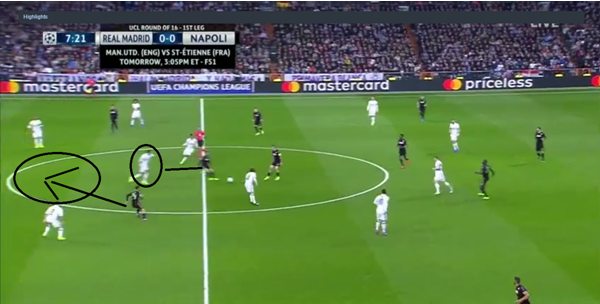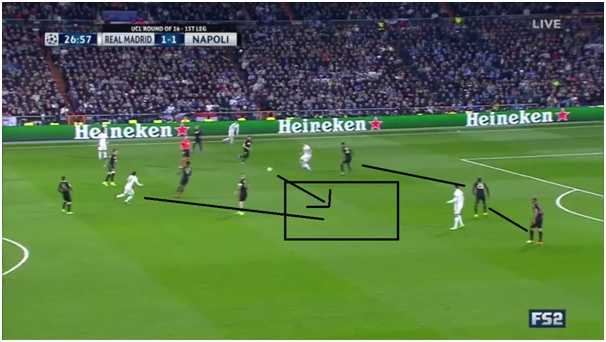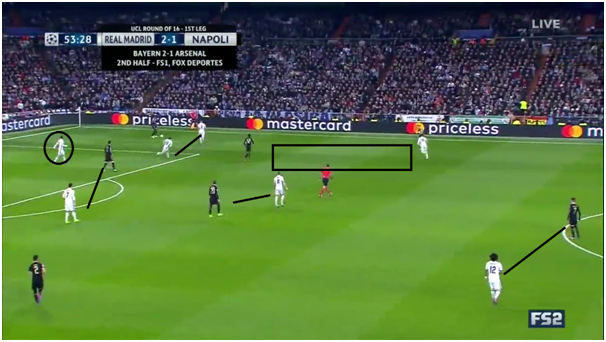Raghunandhanan Narasimhan writes a detailed tactical analysis about the UEFA Champions League match that ended Real Madrid 3-1 Napoli.
Real Madrid hosted Napoli in the round of 16 tie at the Santiago Bernabeu in what was a tougher fixture than what it appeared on paper. Mauro Sarri’s men were unbeaten in their last 18 matches in all competitions and were earning rave reviews for the brand of football they were playing. Real on the other hand looked to consolidate on their home fixture and make sure they could kill the tie in the first leg so that they could make the away trip in two weeks’ time a formality.
Line Ups:

Made using TacticalPad
Real Madrid (4-3-3): Navas; Carvajal, Ramos, Varane, Marcelo; Kroos, Casemiro, Modrić; James, Benzema, Ronaldo.
Napoli (4-3-3): Reina, Hysaj, Albiol, Koulibaly, Ghoulam, Zielinski, Diawara, Hamsik, Callejon, Mertens, Insigne
Napoli’s early goal and Real’s stability later on:
The match started off with both the teams playing in their characteristic set ups and game plans. Real however, looked to press a bit higher than their usual self and tried to disorient the Napoli build up. A frantic start ensued and Napoli were able to take the lead through a brilliant goal from Lorenzo Insigne. Both the teams were intent on looking to force turnovers and hit the other on the counter, identifying transitions as their go-to scheme. Napoli scored a typical Sarri-esque goal and it looked as if Real had not done their homework with Napoli forcing Real into a pressing trap and Insigne getting released beyond the last man. The goal was an absolute peach and Insigne’s awareness and technique to execute the goal was exceptional. However it was the build up prior to the goal that led to the break eventually, with Napoli playing small back passes to draw the Madrid players out of positions and break the lines. This, when combined with the dropping movement of Mertens, saw Varane moving in a man oriented fashion to cover him.

The diagonal run made across by Insigne was found brilliantly by Hamsik as the space vacated by Varane was exploited. This culmination of events is the precise reason why Napoli play back passes and lure the opposition into a pressing trap. Napoli’s swift combinations provided them with the opportunities to break the Real lines and they were able to progress cleanly.

Real Madrid however did not buckle under the circumstances and were able to gain a foothold in the match soon enough. Napoli’s 4-5-1 while defending was compact and ensured that there was not much central penetration from the Real players. The same could be said from Real’s perspective as Casemiro’s positioning in defensive phases ensured that Napoli could not get a firm grip of the central areas. This was mainly the reason as to why both teams resorted to quick transition focused attacks. Napoli switched between a 4-5-1 and a 4-4-2 when the Real players were in possession as they looked to limit the ball playing abilities of Varane and Ramos. It was usually Hamsik who moved forward to assist Mertens in such instances. When the ball was moved from side to side, Callejon and Insigne could move to cover the full backs and thus limit the passing options when moving forward.
The Madrid side were able to gain a foothold in the match with combinational play on the wings. Since Napoli were defending in a 4-5-1 that was intent on closing down the spaces and staying compact, Real could find a lot of space down the flanks. This combined with their advancing full backs ensured that they could enjoy a lot of space down either of the flanks. At times, Napoli’s back line consisted of six players who were dropping down to combat the Real’s wing play. The equaliser from Real was typical of the way they have been playing under Zidane as they doubled up on the wings and a cross into the box was headed in by Benzema.
By using the intelligence of Kroos and Modric, Real Madrid could play past the Napoli lines of pressure in spite of not being tactically diverse to play through them. Modric’s excellence on the ball combined with the technical excellence of the likes of James, Ronaldo, Kroos and Benzema, meant that Real could use swift combinations and play through the lines. An instance in the match saw Modric play the one-two with Benzema who had dropped a bit deep to facilitate the pass. By occupying the space in between the lines, Benzema could help Modric bypass both the lines and play Ronaldo play through on goal only for him to blaze over.

By staying too compact, this swift pass combination saw Modric pull free and play Ronaldo through on goal.
Over compact Napoli exploited on the flanks:
The second half was a bit less frantic but the tempo did not visibly drop much as both teams still looked to attack the other. With Diawara patrolling the midfield in front of his defense, Madrid increasingly looked to attack down the flanks. Unclear pressing schemes adopted by Napoli for their wing coverage was partly the reason why they got caught out often in the flanks. With Ronaldo often drifting to the right flank and James moving inside, Real could achieve superiority on the flanks and in the right half space in particular. With Carvajal’s attacking exploits, Real had a constant outlet to release the ball to. Kroos’ intelligence in such build up play stood out as he held his position to occupy one of the Napoli midfielders and let Modric move forward to progress with the ball. The second goal was again via the wings with Ronaldo able to get to the byline after combining with James.
Napoli increasingly found it difficult to progress the ball from their defense as they kept losing the ball and this proved to be fatal as Casemiro scored a wonder goal from a ball that was not cleared. The pressure from Real is to be lauded though as they moved to press Napoli high up the pitch and force the turnovers.

This was the scenario before the goal as Real pressed in a very high block and overloaded the ball near side. Napoli, playing their usual self, tried passing it out of the press but lacked the positional cohesion to bring the ball out and conceded possession only for Casemiro to score.
By ceding the superiority in the half spaces and growing increasingly compact, Napoli were unable to cover huge spaces on either flank. This meant that once Real could shift the ball to the other flank, usually via Kroos, they could move forward easily without pressure on the ball. Madrid’s profligacy in front of goal meant that they squandered a few other chances that could have ended the tie as a contest. With the two goal lead, Real could shut down the space and look to hit on the counter with the Napoli structure growing increasingly passive as the half wore on. This being said, Napoli still enjoyed decent spells of possession and created a few half chances. Looking to exploit the space in behind the full backs, Napoli started attacking down the flanks too with their full backs increasingly moving forward. Mertens missed a glorious opportunity to score another away goal for his side with combinational play down the right flank. However the score was not to change and both sides trudged to the end of the match with easily lost balls and less cleaner progressions.
Conclusion
Real Madrid were comfortably the better side on the night and were brilliant to come back into the tie after conceding the early goal. Napoli gave them a tough day put nonetheless and are still in this tie due to Insigne’s goal. The quality of the players in the two sides played a part in determining the result and the second leg promises to be a great match by the looks of how this match panned out.
Read all our tactical analyses here
Manchester United fan and a tactics afficianado. Loves quality holding midifielders

























































